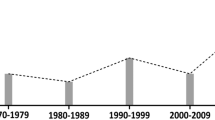Summary
Morphological and chemical examinations of the extractives of the tissues and shake contents of eight Dacrydium and one Podocarpus species have been made. The whitish deposits in heart-shakes are without exception mainly podocarpic acid (PCA). This compound occurs also in the tissue of samples but only when shakes are found nearby. Accordingly PCA is regarded as an anomalous extractive, synthesized in response to those conditions resulting in shake formation. In samples with shakes PCA is present in very small amounts at the sapwood-heartwood boundary and in one sample there were traces even in the innermost sapwood. It was notable that shakes containing deposits can arise in those Dacrydium species with coloured heartwood and with a known tendency for wetwood formation. On the other hand Dacrydium franklinii does not develop coloured heartwood or wetwood or shakes, and the lack of these features may have taxonomic significance.
Similar content being viewed by others
References
Baggaley, K. H.; Erdtman, H.; McLean, N. J.; Norin, I.; Eriksson, G. 1967. Chemistry of the order Podocarpales, Pt. I. Acta Chem. Scan. 21: 2247–2253
Bauch, J.; Höll, W.; Endeward, R. 1975. Some aspects of wetwood formation in fir. Holzforschung 29: 198–205
Brandt, C. W.; Thomas, B. R. 1951. Resins of the Dacrydium and Podocarpus genera. Wood resin from Dacrydium cupressinum (Rimu). N.Z. J. Sci. Tech. 33: 30–37
Erdtman, H. 1963. Some aspects of chemical taxonomy, pp. 89–126. In: Chemical Plant Taxonomy, ed. by T. Swain. New York: Academic Press
Hart, J. H. 1965. Formation of discoloured sapwood in three species of hardwoods. Quart. Bul., Mich. State Univ. Agric. Exper. Sta. 48: 101–116
Hartley, C.; Davidson, R. W.; Crandall, B. S. 1961. Wetwood, bacteria and increased pH in trees. U.S. For. Prod. Lab. Rep. 2215
Hillis, W. E. 1971. Distribution, properties and formation of some wood extractives Wood Sci. Technol. 5: 272–289
Jacobs, M. R. 1939. Further studies on fibre tension. Commonwealth Forestry Bureau Australia Bulletin No. 24
Knutson, D. M. 1973. The bacteria in sapwood, wetwood and heartwood of trembling aspen (Populus tremuloides). Can. J. Bot. 51: 498–500
Krahmer, R. L.; Hemingway, R. W.; Hillis, W. E. 1970. The cellular distribution of lignans in Tsuga heterophylla wood. Wood Sci. Technol. 4: 122–139
Kübler, H. 1959. Studien über Wachstumsspannungen des Holzes. Holz Roh- Werkstoff, 17: 1–9; 44–54
de Laubenfels, D. J. 1969. A revision of the Malesian and Pacific rainforest. Conifers I. Podocarpaceae. J. Arnold Arbor. 50: 274–314
McGinnes, E. A.; Chang, C. I.-J.; Wu, Ky-T. 1971. Ring shake in some hardwood species. J. Polymer Sci. Part C. (36): 153–176
Reid, J. S. 1956. The properties and uses of Rimu Dacrydium cupressinum. New Zealand Forest Service Info. Ser. No. 2
Sachs, I. B.; Ward, J. C.; Kinney, R. E. 1974. Scanning electron microscopy of bacterial wetwood and normal heartwood in poplar trees. Proc. 7th Ann. Scanning Electron Microscope Symp. (Part II): 453–460
Schroeder, H. A.; Kozlik, C. J. 1972. The characterization of wetwood in western hemlock. Wood Sci. Technol. 6: 85–94
Shain, L. 1971. The response of sapwood of Norway spruce to infection by Fomes annosus. Phytopath. 61: 301–307
Shain, L.; Hillis, W. E. 1971. Phenolic extractives in Norway spruce and their effects on Fomes annosus. Phytopath. 61: 841–845
Sherwood, I. R.; Short, W. F. 1938. Podocarpic acid. Part I. J. Chem. Soc. 1006–1013
Shigo, A. L. 1967. The early stages of discoloration and decay in living hardwoods in northeastern United States: A consideration of wound-initiated discoloration and heartwood. XIV. IUFRO Congress, Vol. IX. Section 41. Munich: 117–133
Shigo, A. L.; Hillis, W. E. 1973. Heartwood, discolored wood, and microorganisms in living trees. In: Ann. Rev. Phytopath. 11: 197–222
Shigo, A. L.; Sharon, E. M. 1970. Mapping columns of discolored and decayed tissues in sugar maple, Acer saccharinum. Phytopath. 60: 232–237
Ward, J. C.; Kuntz, J. E.; McCoy, E. 1969. Bacteria associated with shake in broad leaf trees. Phytopath. 59: 1056
Author information
Authors and Affiliations
Additional information
The third author expresses his gratitude to the Division of Building Research, CSIRO, Highett, Vic., for a visiting Fellowship during 1974.
Rights and permissions
About this article
Cite this article
Hillis, W.E., Yazaki, Y. & Bauch, J. The significance of anomalous extractives in heart-shakes in Dacrydium species. Wood Sci.Technol. 10, 79–95 (1976). https://doi.org/10.1007/BF00416784
Received:
Issue Date:
DOI: https://doi.org/10.1007/BF00416784




